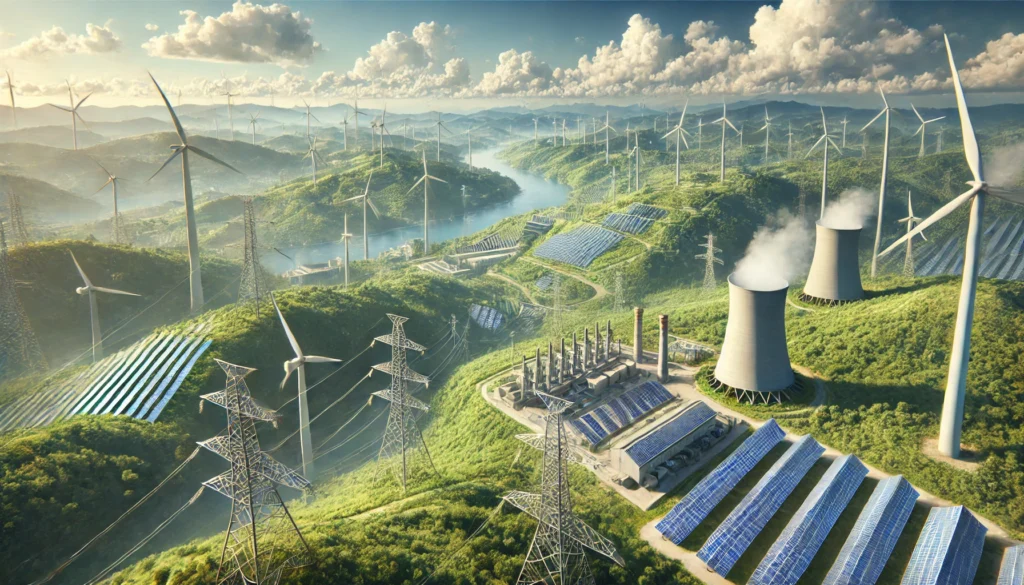The renewable energy zones appendix 3 highlights the strategic areas identified for renewable energy development, promoting sustainability and reducing carbon emissions. This appendix outlines critical guidelines for establishing and managing these zones. Understanding renewable energy zones Appendix 3 is essential for driving future green energy initiatives.
The Concept Behind Renewable Energy Zones Appendix 3
Renewable Energy Zones Appendix 3 refers to a strategic approach to identifying areas ideal for renewable energy projects.
These zones are selected based on the availability of resources like solar, wind, and hydro. Concentrating on renewable energy projects in these zones helps reduce costs and improves efficiency.
The concept also promotes sustainable energy by focusing on regions that can produce consistent energy. Appendix 3 outlines the criteria for designating these zones and their role in energy development.
These zones also act as hubs for innovation, where new technologies in renewable energy are tested and implemented. Additionally, Renewable Energy Zones Appendix 3 allows for better coordination between the government and private sectors.
The overarching goal is to accelerate the global transition to renewable energy by creating a framework for organized development. Finally, this concept supports national energy strategies by providing a clear plan for integrating renewable sources into the grid.
Benefits of Establishing Renewable Energy Zones
Renewable Energy Zones offer a range of benefits, starting with cost reduction. By grouping renewable projects together, infrastructure like transmission lines can be shared, saving money. These zones also simplify the permitting process since they are pre-approved for renewable energy development.
Environmental impact is minimized, as zones are chosen with sustainability in mind. Establishing these zones ensures a steady increase in renewable energy capacity.
Another benefit is that Renewable Energy Zones encourage investment by providing a clear framework and reducing risk. Developers know that the infrastructure and regulatory support are already in place, which attracts more projects.
These zones also create jobs and boost local economies. Lastly, by centralizing renewable energy production, nations can meet their climate targets more effectively and on schedule.
Challenges in Implementing Renewable Energy Zones Appendix 3
Implementing Renewable Energy Zones Appendix 3 comes with several challenges. One major challenge is finding suitable land, especially in areas with existing infrastructure. Competing interests, such as agriculture or urban development, can create conflicts over land use.
Another issue is the cost of initial infrastructure, such as transmission lines, which can be a financial burden. In some cases, local communities may resist the establishment of renewable energy projects due to concerns about environmental or social impacts.
Regulatory delays also present a significant hurdle. Even with Renewable Energy Zones Appendix 3, developers must navigate various environmental and legal approvals, which can slow down progress.
Finally, technological limitations, such as the ability to store renewable energy, add another layer of complexity. These challenges must be carefully managed to ensure the success of renewable energy zones.
Key Factors Driving the Need for Renewable Energy Zones
Several key factors are driving the need for Renewable Energy Zones. First, the increasing global demand for clean, sustainable energy has made these zones essential.
Governments around the world are pushing to reduce carbon emissions, and renewable energy zones provide a focused solution. Additionally, technological advancements in renewable energy, such as improved solar panels and wind turbines, make these zones more viable.
Another driving factor is the need for energy security. Renewable Energy Zones help diversify the energy supply, reducing dependence on fossil fuels. They also support economic growth by attracting investment in green energy projects.
Lastly, international agreements, like the Paris Climate Accord, are pushing countries to adopt renewable energy strategies, making these zones even more crucial.
Renewable Energy Zones Appendix 3: Policies and Regulations
Renewable Energy Zones Appendix 3 is governed by a set of policies and regulations designed to streamline development. These policies provide clear criteria for zone selection, focusing on areas with abundant renewable resources.
Environmental regulations ensure that renewable energy projects within these zones meet sustainability standards. Additionally, the government offers incentives such as tax credits and grants to encourage development in these zones.
The regulations also focus on simplifying the permitting process for renewable energy projects. This allows developers to get approval faster and start construction sooner.
Furthermore, Renewable Energy Zones Appendix 3 outlines guidelines for land use, ensuring that renewable projects do not interfere with agricultural or urban areas. These policies create a favorable environment for renewable energy investment while safeguarding environmental and social interests.
Future Prospects for Renewable Energy Development
The future of renewable energy development looks promising, particularly within Renewable Energy Zones. As technology continues to advance, the efficiency and cost-effectiveness of renewable energy will improve.
These zones will play a critical role in scaling up renewable energy capacity to meet global demand. Governments are also likely to expand the number of zones and provide additional incentives to encourage investment.
Moreover, Renewable Energy Zones will continue to attract private sector investment, driving innovation in areas like energy storage and smart grid technology.
The focus will also shift towards integrating renewable energy into existing infrastructure. In the long run, these zones will help countries meet their climate goals and transition to a fully sustainable energy system.
Technological Advancements in Renewable Energy Zones
Recent technological advancements have significantly boosted the efficiency of Renewable Energy Zones. Improved solar panels and wind turbines now generate more power with fewer resources.
Energy storage technologies, like advanced batteries, allow renewable energy to be stored and used during peak demand times, addressing one of the major challenges of renewable sources.
Smart grids are another key advancement, enabling more efficient management and distribution of energy produced in Renewable Energy Zones. These grids help balance supply and demand, reducing the risk of energy waste. Innovations in energy transmission have also allowed for more efficient transport of electricity over long distances from remote renewable zones to urban areas.
Additionally, artificial intelligence and machine learning are being integrated into renewable energy systems, optimizing performance and reducing maintenance costs. AI can predict weather patterns to adjust energy production in real time.
Lastly, offshore wind technology has opened up new opportunities, expanding the reach of Renewable Energy Zones to ocean-based installations.
Renewable Energy Zones Appendix 3: Impact on Local Economies
The establishment of Renewable Energy Zones Appendix 3 can have a profound impact on local economies.
First, these zones create jobs, both during the construction phase and once the energy projects are operational. Skilled labor is required for everything from installation to ongoing maintenance of renewable energy infrastructure.
Local businesses benefit from increased demand for goods and services, such as equipment, housing for workers, and other logistical needs. Moreover, the revenue generated from renewable energy can be reinvested into the community, supporting public services and infrastructure development.
Renewable Energy Zones Appendix 3 also attracts investment from both domestic and international companies, boosting economic growth in the area.
Additionally, the cost of energy in these regions often decreases, benefiting local industries and residents alike. Lastly, local governments can collect taxes or fees from renewable energy projects, which can be used to fund further development or social programs. This creates a positive cycle of economic benefits.
Environmental Benefits of Renewable Energy Zones
Renewable Energy Zones contribute significantly to reducing carbon emissions by replacing fossil fuels with clean energy sources.
Wind, solar, and hydro energy projects generate power without releasing harmful greenhouse gases, making them environmentally friendly. This helps countries meet their climate targets and reduces global warming.
The localized focus of Renewable Energy Zones also minimizes land use and environmental degradation. Because these zones are pre-selected for their suitability, they avoid ecologically sensitive areas.
Additionally, renewable energy requires less water compared to traditional power plants, conserving a vital resource in regions that establish these zones.
Biodiversity is another area that benefits from renewable zones. Unlike coal or gas plants, renewable projects have minimal impact on local wildlife and habitats.
Finally, the long-term sustainability of renewable energy contributes to a healthier environment for future generations, ensuring cleaner air and reduced pollution.
Government Initiatives Supporting Renewable Energy Zones
Governments worldwide are playing a crucial role in promoting Renewable Energy Zones. Many have implemented financial incentives such as tax breaks, subsidies, and grants to encourage developers to invest in renewable energy projects. These initiatives reduce the cost burden and make renewable energy more competitive with fossil fuels.
Policies are also in place to simplify the permitting and regulatory processes, making it easier for companies to develop projects within Renewable Energy Zones. Additionally, governments are investing in infrastructure, such as upgrading transmission lines, to support the efficient transport of energy from these zones to consumers.
Public awareness campaigns are being launched to educate citizens about the benefits of renewable energy, increasing public support for these projects.
Lastly, international agreements, such as the Paris Climate Accord, are pushing governments to meet specific renewable energy targets, further encouraging the growth of these zones.
How Renewable Energy Zones Appendix 3 Aligns with Global Goals
Renewable Energy Zones Appendix 3 aligns directly with global sustainability goals, particularly those outlined in international climate agreements.
The zones contribute to the reduction of greenhouse gas emissions, which is a critical objective in the fight against climate change. They provide a structured approach to scaling up renewable energy production, making it easier for nations to meet their renewable energy targets.
These zones also support the United Nations’ Sustainable Development Goals (SDGs), particularly Goal 7, which calls for affordable, reliable, sustainable, and modern energy for all. Renewable Energy Zones Appendix 3 fosters international cooperation by encouraging the sharing of technology and best practices in renewable energy development.
In addition, by promoting sustainable energy, these zones contribute to long-term environmental preservation. They also support economic growth by creating jobs and fostering new industries, which aligns with global efforts to reduce poverty and inequality.
Lastly, these zones help ensure energy security by diversifying the energy mix and reducing dependence on fossil fuels.
The Last Word on Renewable Energy Zones Appendix 3
The future of renewable energy zones Appendix 3 looks promising as the world moves toward a more sustainable energy system. As renewable energy technologies continue to advance, these zones will become even more efficient and cost-effective. Governments and private investors are expected to expand the number of Renewable Energy Zones globally, further integrating clean energy into national grids.
Offshore wind farms and other innovative renewable energy projects will likely play a greater role, allowing countries to harness new sources of energy. Additionally, energy storage advancements will enable Renewable Energy Zones to provide more consistent and reliable power, overcoming one of the current limitations of renewable energy.
In the long term, these zones will help countries meet their climate goals, reduce carbon emissions, and ensure energy security. As renewable energy becomes the dominant form of energy, Renewable Energy Zones will be at the heart of this global transition, leading the way toward a more sustainable world.


